JOSEP MARIA Rosselló I VIRGILI
( XEMA ROSSELLÓ )
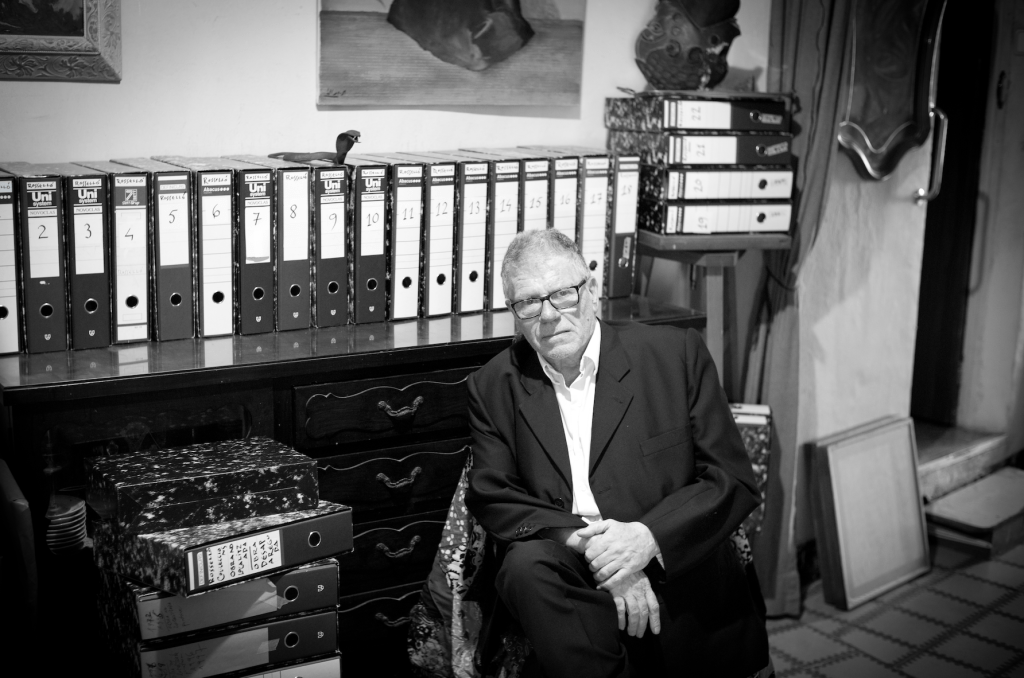

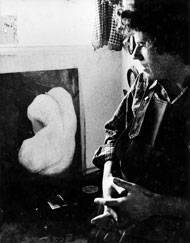
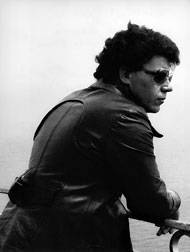
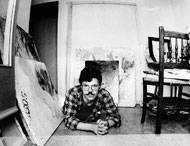
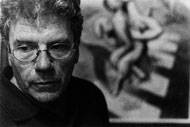
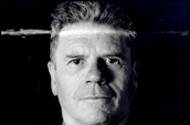
Biography
Born in Tarragona in 1950. He studied at the Tarragona School of Art, the Sant Jordi School of Fine Arts, and engraving at the Escola Massana in Barcelona. His teachers were the painters Magda Folch and Guillem Bergnes.
He collaborates with the Gran Teatre del Liceu. He resided in Sitges from 1969 to 1983.
He draws for the magazine Escrivim a les parets – Revista de les Arts (Balaguer), for the weekly L’Eco de Sitges, for El Món (Barcelona), and for the magazine Bonart (2003). He experiments in the field of music, accompanied by pianist Charles Miles.
From 2003 onwards, he contributes articles to Bonart, Diari Avui, Nou Diari, Revista del Centre de Lectura de Reus, Diari de Tarragona, El Punt, Caldodecultivo (Tarragona), Més Tarragona, Entitats, the visual poetry magazine Veneno (Córdoba), Letras Travestidas (Uruguay).
Artistic Career
- 1983: He moved to Madrid and then to Rome for the murals of Pascua Popular Flamenca, by Salvador Távora and La Cuadra de Sevilla. He also collaborated on Piel de Toro and in “Arte en la Calle” productions with Santiago Amón. He participated in the project for the Plaza de Salvador Dalí (Madrid).
- He moved to Tangier to work with the Carmen Maceín Foundation.
- 1992: He returned to Catalonia, created the poster for the Centenary of the Modernist Festivals of Sitges, and two collections of etchings (La creació and Fades). He presented works at the Tarragona Cathedral and the Sanctuary of Jesus and Mary.
- 1990s and 2000s: He undertook multiple collaborations with Salvador Távora, designed costumes and festive pins, presented sculptures and urban projects, and developed live works at jazz festivals and with orchestras.
- He collaborates with writers such as Olga Xirinacs and Jordi Cervera on painting, illustration, and book projects.
- 2000-2010: He participated in projects such as Cadavre-exquis, Cadavre & Grafit, Suite Coltan, and experimental exhibitions.
- He writes and publishes various books (Rosselló-Dibuixos 1968-2002, Suite Coltan, Lorca, la incógnita visita, etc.).
- 2011-2015: Projects for the Teatre Tarragona, exhibitions such as Creació – Destrucció, and the closing of the Catàleg Raonat (2017).
Exhibitions
Notable Solo Exhibitions
- 1967 Tarragona, Sala d’Iniciatives i Turisme
- 1968 Reus, Centre de Lectura
- 1969 Tortosa, Centre de Comerç
- 1970 Tarragona, Vilanova i la Geltrú, Barcelona (Ateneu Barcelonès)
- 1971 Sitges, Barcelona (To the Poet Federico García Lorca)
- 1972 Bologna (Italy)
- 1973 Barcelona, Art Nou Sitgne
- 1974 Madrid, Skira Galleries
- 1975 Barcelona, Galeria As
- 1976 Barcelona, Art-Expo; The Hague, Nostalgallery; Madrid, Skira
- 1977 Tarragona, Vendrell
- 1978 Lleida, Balaguer
- 1979 Girona, Lleida, Zaragoza, Sitges
- 1980 Barcelona (with La Cubana), Castell de Sant Martí
- 1981 Vilanova i la Geltrú
- 1982 Paris, Bohler Gallery
- 1983 New York, Paul Stooshnoff Gallery
- 1984 New York, Skira Leesing Gallery; Rome, Quirino Theatre
- 1985 Seville, Piel de Toro
- 1987 Switzerland, Pierre Gianada Foundation
- 1988 Paris, Bohler Gallery
- 1989 New York, Stooshnoff Gallery
- 1990 Tarragona, Sant Miquel d’Escornalbou
- 1991 Tangier, Carmen Maceín Foundation
- 1992 Barcelona, Biblioteca de Catalunya; Tangier, Picasso, Góngora, Rosselló
- 1993 Tarragona, Cathedral
- 1994 Tarragona, Museum of Modern Art
- 1995 Sitges, Santiago Rusiñol Library; Cadiz and Barcelona (Identidades)
- 1996 Reus, Fortuny Theatre (KRMN), Lleida
- 1998 Tarragona, Reial Club Nàutic; Balaguer
- 1999 Tarragona, Ribes Art; Tàrrega
- 2000 Madrid, Hotel Reina Victoria; Tarragona, Old Town Hall; Museum of Modern Art
- 2001 Barcelona, Mercat de les Flors; Calafell; Castell d’Escornalbou; Vila-seca; Tortosa
- 2002 Lleida, Tarragona, Vila-seca, Tortosa, Sitges, Zaragoza
- 2003 Girona, Tarragona, Sitges, Barcelona, Madrid, Parma
- 2004 Zaragoza
- 2006 Tarragona, Llac Exhibition Hall
- 2009 Orlando, Florida (USA)
- 2010 Tarragona, Museum of Modern Art
- 2011 Lleida, Forte dei Marmi (Italy)
- 2012 Bolzano, Paris, Tarragona
- 2014 Centelles, URV Tarragona
- 2015 Tarragona, Tinglado 1 (Creation – Destruction)
- 2016 Tarragona, city gardens
Group Exhibitions
He has participated in numerous group exhibitions throughout Catalonia, Spain, and Europe.
Public Spaces
His work is part of the collections of:
- Biblioteca de Catalunya
- Museum of Modern Art of Tarragona
- Picasso Foundation (Málaga)
- Museo Reina Sofía (Madrid)
- Biblioteca Nacional (Madrid)
- Centre Georges Pompidou (Paris)
- Diocesan Museum of Tarragona
- Federico García Lorca House-Museum (Granada)
- Conservatori del Liceu (Barcelona)
- Tarragona City Council
- Catalan Red Cross
- Universitat Rovira i Virgili
“since Tarragona is not Empordà, Rosselló is not Dalí”
Xavier Barràl i Altet
“Rosselló’s Art is Pure Mysticism. It Grasps the Unrevealed Secrets of Life. His is a Beautiful, Relevant, and above all, Poetic Project.”
Calixto Bieito.
“Rosselló’s Work is Rooted in an Expressionism without Gesticulating Deformations, but rather Very Introspective, with Intimate Tensions Resolved in a Cold Range of Blues and Blacks, with some Ghostly Pinks.”
Rafael Santos Torroella
“Rosselló’s Painting is a Point of Arrival for Disparate Currents, while also a Point of Departure towards the Magical”
José Hierro.
“the Mystery that is Always the Environment and the Category of Love Captures the Entirety of the Image, and in the Mysterious Lyricism of these Works, the Artist Pays Homage to the Creators of His Time, Presents His Theory of Poetry and Dreams, of Man who, Traversing the Dual Path of Love and Death, Moves towards His Annihilation.”
Raul Chavarri
“Contemplating Rosselló’s Work is an Invitation to Encounter the Lyrical in its Profound Sense of Surreal Analysis.”
Emilio Rey
“the Plastic Poetry of Josep Maria Rosselló Magically Explains those Words of Lorca: Poetry Does not Want Adherents, it Wants Lovers.”
Jordi Bertán
“Spectators of Such Rich and Complex Scenarios Move from one Work to another with the Feeling that there are Still Elements to Discover and that the Interpretations and Perceptions are, in Reality, more Complex than What We Initially Perceive.”
Vinyet Panyella
“within a Personal and Very Characteristic Figuration that is Largely Dreamlike, Rosselló’s Painting Captures the Attention of Plastic Arts Enthusiasts Due to its Internal Dynamism and the Reflection that Color Evokes.”
Josep Maria Cadena
“During a Reception Held in His Honor at the International Museum of Contemporary Art in Tangier, Carmina Maceín Foundation, Rosselló Proceeded to an Unusual Demonstration by Creating, in the Space of one Minute, a Magnificent Painting on a Piece of Glass one and a Half Meters Long and Fifty Centimeters Wide.
Then, before the Unanimous Admiration of the Audience, which Included Several Moroccan and Spanish Personalities from the World of Letters and Arts, He Stepped Back a few Meters and Threw a Stone at His Work, Shattering it into Pieces of Glass.”
A. Bakat
“the Performance Lasts Approximately one Hour and Twenty Minutes. That is Enough for the Catalan Painter Rosselló to Paint a Large Canvas on a Raised Platform at the Back of the Shadowed Stage, in Turn Recreating the Characters and Emblems of the Passion, as a Counterpoint and Organic Complement to the Spectacle (Flashes of Light Allow, from Time to Time, to Follow the Stages of the Work). His Signature, or Mark, is a Clean Cut on the Left Side of the Painting, like an Open Wound. Many are the Wounds, Difficult to Heal, that Spain, along with the Whole World, Bears in its Flesh.”
Aggio Savioli
“Rosselló is a Creative Spirit; He Does not Fear Work, He Cherishes it. The Noblest Designs Guide His Hand. He Lives to Share His Passion for the Beauty He Discovers Everywhere, He Shapes it, Paints it, Writes it, Proclaims it, Always Steeped in the Mediterranean.”
Jordi Rovira
